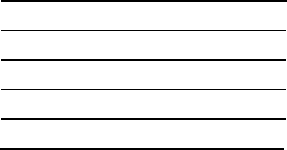
You administer ARS by developing a group of ten tables like the sample table below.
TABLE 1
AREA CODE/EXCHANGE
0) —
1) —
2)— 3)—
4) — 5) — 6) —
7—
8) — 9) —
POOL
OTHER DIGITS
0)—
1) —
2)—
3)—
4) —
5)—
Tables O through 7 consist of three sections. The Area Code/Exchange section at the
top of each table contains up to ten 3-digit area codes or exchanges. You need to
use two tables if you have more than ten entries that should follow the same pool
routing pattern, for example if you have a WATS band that covers more than ten area
codes.
The Pool Number section of each of these tables contains the numbers of line pools
(9, 890-899), listed in the order you want them selected for calls made to the area
codes and exchanges entered in the corresponding Area Code/Exchange section.
The Other Digits section of each of the tables contains any additional digits required
for the call, such as access codes and account codes needed to place calls using
alternate long distance companies. When someone places a call that is routed
through this table entry, the system automatically dials the necessary digits and
pauses before the telephone number.
Tables 8 and 9, the default tables, have Pool Number and Other Digits sections only.
Table 8, the Default Toll Table, is used for long distance calls to all area codes that
aren’t listed in Tables O through 7. Table 9, the Default Local Table, is used for local
calls to all exchanges that aren’t listed in Tables 0 through 7. If someone dials digits
that do not match any of the entries in Tables 0 through 7, the system automatically
routes toll calls to the pools listed in Table 8 and local calls to the pools listed in
Table 9.
People in your business may need to call the following special numbers for informa-
tion or for help or to place toll-free calls: 0, 411, 611, 911, 800, and 900. When your
system was first set up, these six numbers were automatically assigned as the only
entries in the Area Code/Exchange section of the Special Numbers Table. Pool 9,
the main pool, was automatically assigned as
the only entry in
the Pool Number sec-
tion of the Special Numbers Table. You cannot change these table entries.
If you must dial an access number such as 9 before dialing 0 to reach the operator,
you can enter this access code in the Other Digits section of the Special Numbers
Table. If you want to use a different pool to reach one of these special numbers, you
can place the special number in the Area Code/Exchange section of a table that
routes calls to the pool you prefer instead of to the main pool.
47
